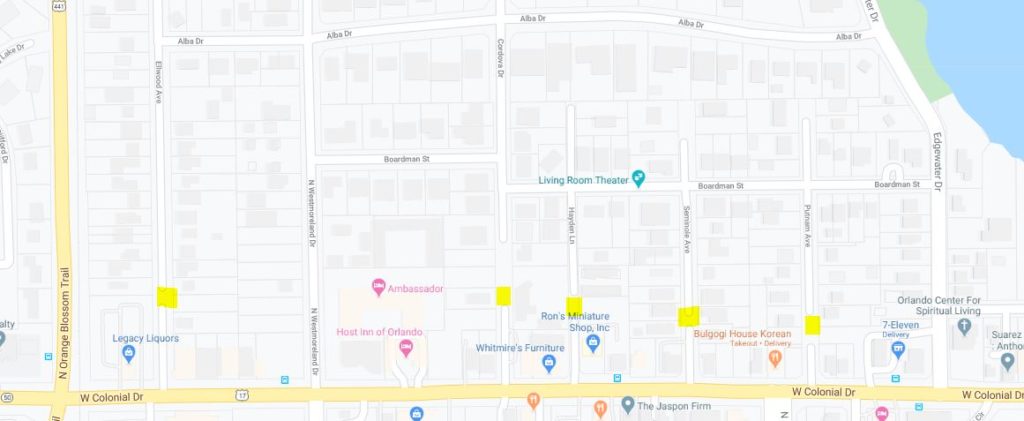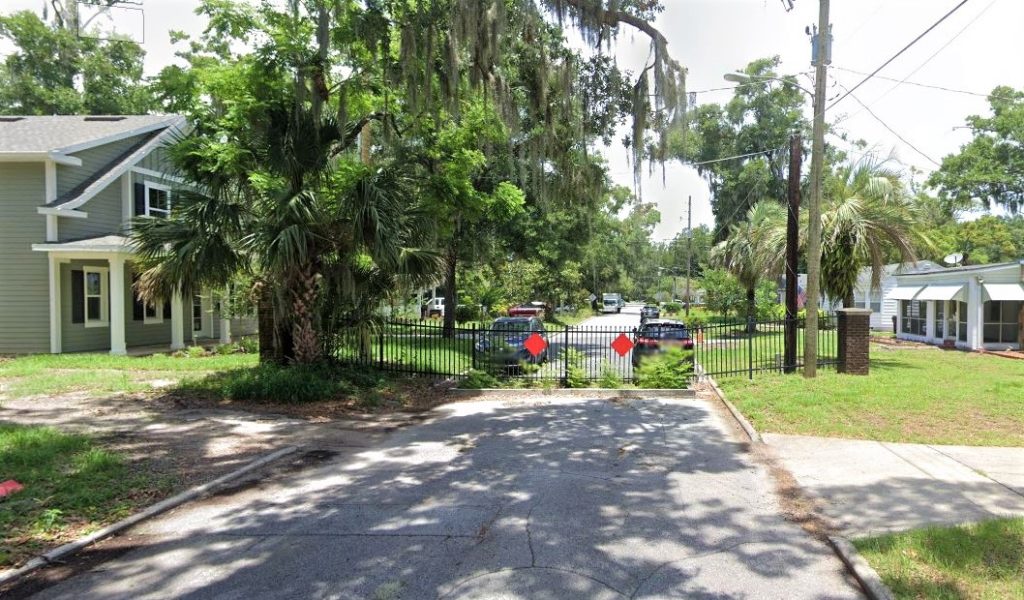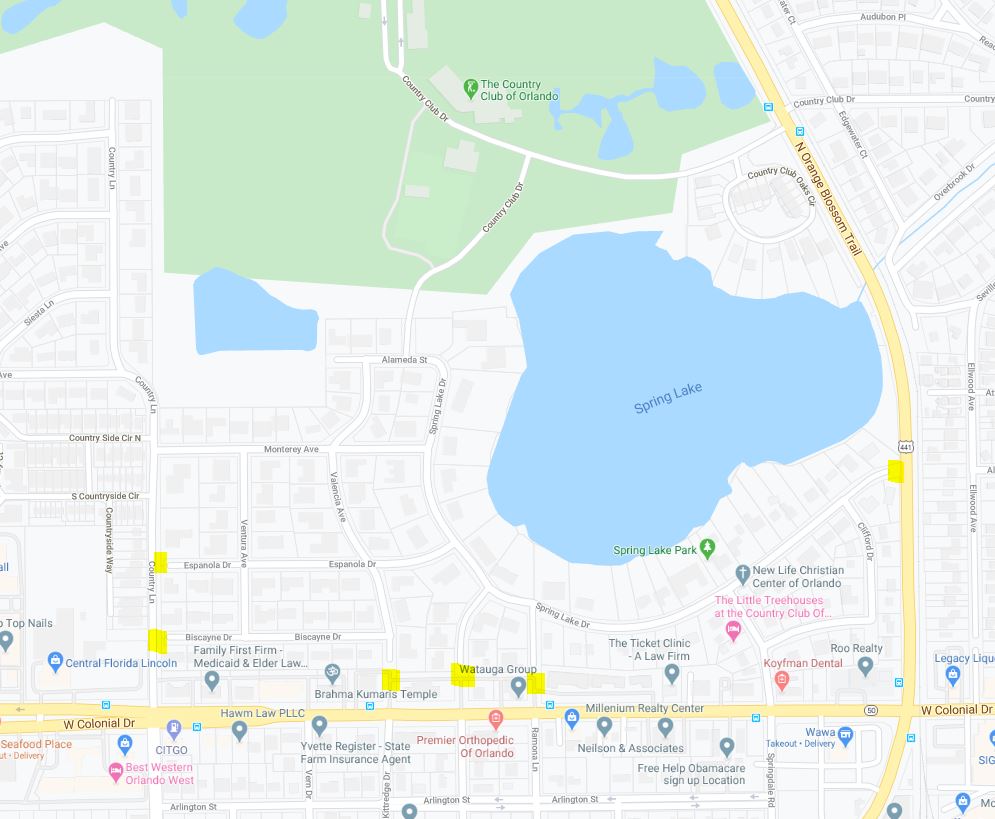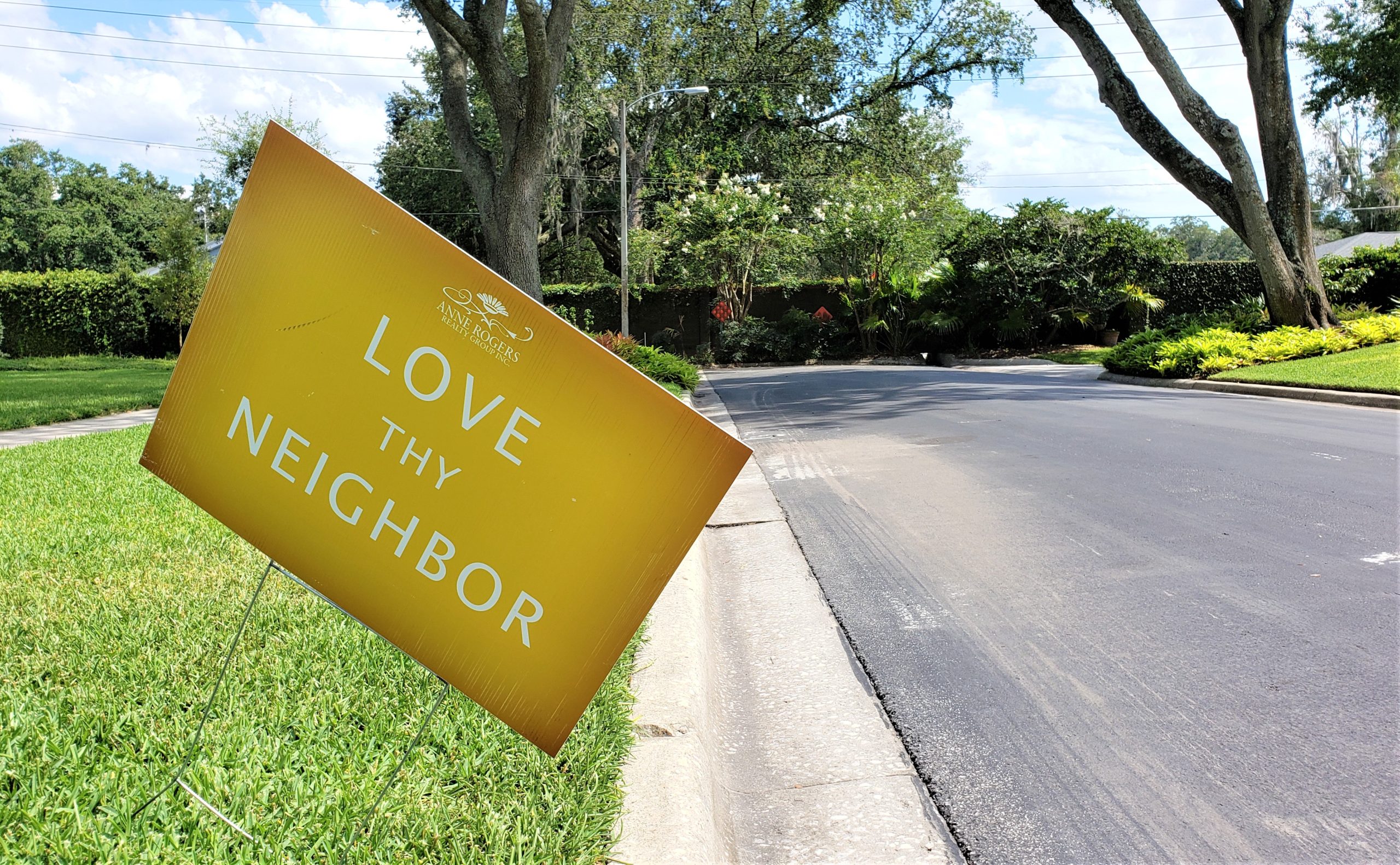“Hey Bungalower, what’s up with the BLACK FENCES that block College Park from Parramore?”
– Bungalower Reader
In 1994, cut-through traffic in south College Park, just north of Colonial Drive, was seen as a major contributing factor to crime in the area – according to AreaVibes.com, College Park has a D+ for Crime Rates based on 2018 stats. In an effort to protect the residents who live along the northern edge of Colonial, Orlando officials decided to wall off five neighborhood roads to traffic.
The City, with approval from the residents in the area, closed off a number of streets between Edgewater Drive to Ellwood Avenue and Colonial Drive to Lake Adair with a series of fences. One year later Colonial Drive was widened to five lanes – an added buffer between two estranged neighborhoods.

City staff erected the fences at varied points on each road, creating deadends to block the traffic and force commuters to use Westmoreland Drive, Edgewater Drive, and Orange Blossom Trail to travel north and south.

The effort was meant to be temporary, to allow the City of Orlando to conduct studies to see how the closures would affect the flow of traffic in the neighborhood and to measure any reductions in crime.
The nearby Spring Lake neighborhood, also located on the northern side of Colonial Drive, had a number of its streets sectioned off from cut-through traffic but in their case, they used actual walls instead of fencing, as seen in our lead photo above. It’s important to note that only southward-flowing streets have been shut off to cut-through traffic.

Orlando Sentinel shared a story in 2003 concerning a movement in Arlington Heights, a neighborhood in Parramore that runs along the southern edge of Colonial Drive just across the street from College Park, where residents were petitioning the City to assist them with their own fences to shut down streets there. However, sitting councilmember Daisy Lynum, told them that fences don’t solve crime and Council rejected the idea, and when questioned about the College Park and Spring Lake fences said, “I don’t live in College Park. I don’t represent them.”
Deterring crime through design can be effective, and research has shown that closing neighborhood streets and alleys can actually prevent crime as there is a proven relationship between street access and crime rates, as more frequently traveled streets are more vulnerable to crime. Burglars are known to avoid cul-de-sacs and closely-knit neighborhoods where they are more likely to be seen.
Despite the numbers though, physical barriers to crime still don’t address their underlying causes and often just provide short-term relief and they can be seen to completely divide communities along social and racial lines. Design answers like fences and enhanced public lighting need to be accompanied by other measures to affect longterm change, including active resident involvement, tougher tenant-screening policies, and sometimes an increased police presence.
But the short answer to the question, Bungalower Reader, is that they were put there by the City of Orlando to help deter crime from outside of the, predominantly white, neighborhood.


From the introduction to the research article cited, “Typically, more (less) accessible streets, for which urban movement and public awareness of them will be highest (lowest), are found to experience more (less) crime (e.g., Bevis and Nutter 1977).”
This is terrible research – it’s looking at testing crime theory, not actual crimes.
Closing streets with fences doesn’t lower crime, it protects home values – that’s the primary motivation here. I bet if you looked at crimes 5 years before and 5 years after, it would be relatively the same. But if you looked at home values… I bet it went up after the fences were installed.
We live in a community defined by the City of Orlando as Rock Lake with two neighborhood associations. We are not the only neighborhood with two associations.The community begin south of Colonial Drive, the boundaries Orange Blossom Trail to Texas Avenue one block from John Young Parkway and West Washington to Colonial. I enjoyed this piece because I lived it.While we were not the target of this article west of Orange Blossom Trail and south of Colonial we saw the same thing happen. Many of the homes in this community became flight because families did not want to send their children to Jones High School. So we got the same quality of houses as College Park and Spring Lake (north of Colonial) for maybe $30,000 to $40,000 less than Colonial north side communities. A neighbor a retired Veteran did the neighborhood study about closing the streets in Rock Lake. Susan Harris City of Orlando and Commissioner Daisy Lynum can provide more information about this story. While we were not involved in this study we had many of the same issues, like people of the evening Male and Female walking the trail. I think it took 6 years for this separation of streets to happen near our neighborhood. The community west of the trail and north of Colonial hire a police to patrol. I get it because some of the West Colonial Drive activities require a strong neighborhood presence. With our two associations we are strong advocates for each other and the non members. We will not become a hot spot for crime. Our community changed the boundary for predators because if you look at an article about a guy who moved to Orlando to create a village for predators when they closed the school at Colonial (now Wawa) our property was a prime location to house 8 to 10 people in a duplex. His village was near our homes so neighbors appeared at a City Council meeting to lobby for change. And as a community we made that change. Orlando once a lazy town is now a concrete jungle. Florida is water and in time we will all respect that! This virus is teaching America many lessons.
Thank you for this article; I have never seen it addressed in print before, but I’m glad you did.
I’ve lived in Spring Lake Manor, one block south of the Spring Lake Wall, for 25 years, and I remember the failed effort to close a few of our streets, but that’s another topic.
A bit of history that I think is relevant to your article is that our Rock Lake/Spring Lake Manor/Oakdale Park subdivision, (as it has variously been called throughout its history,) was originally developed as an annex to Orlando Country Club’s Spring Lake subdivision, and our neighborhoods to the north and south of Colonial Drive were contiguous: both physically, connected by five cross-streets on Colonial, (three of which are now barricaded on the north side,) and racially, through segregationist Covenant Restrictions that barred blacks and Jews from living here. When legal segregation was abolished and black families began moving into Rock Lake, Spring Lake chose to amputate its southern appendage with the aforementioned walls; judging by how these two neighborhoods have fared, this action was to its benefit, if not to ours.
College Park residents, under the leadership of then-councilperson Vicky Vargo, later emulated this successful exercise in municipally-engineered segregation. What was once perceived as a conveniently close-but-constrained servant class in the Parramore came to be perceived as inconveniently close-and-unconstrained underclass when constraints and servitude were lifted. For them, physical barricades have been a very effective replacement; the lines of demarcation between white and black Orlando have mostly held firm for the last century, and the few who’ve crossed those lines are the exceptions, not the rule.
Back to the question you pose in the title: “What’s up with the walls,” almost seems to imply that something’s new, or newly noticed, but nothing about these walls is new; the walls are just a literal, physical replacement for segregation laws. Both were funded by our taxes. Both were the work of our elected leaders. Both protect the privileged. Both keep the riff-raff out.
But I’m glad you asked the question.
What’s “up” is a physical infrastructure that speaks more loudly about who we are as a city than any platitudes about equality and inclusiveness. What’s up is a continuing policy of segregation. And it’s more monumental than any confederate statue.
(Your article cites a Sentinel Article that, I think mistakenly, attributes the failed effort to Arlington Heights, but this was difficult to confirm because the link you provided (https://seeclickfix.com/college-park_orange/categories/traffic) does not lead to the cited article. Just in case it matters.)